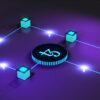Seeking increased transactional control and capability, Bitcoin introduced the Lightning Network that enables people to make transactions off the blockchain. The network was created to address the pertinent issue of scalability that has long been a concern within the crypto community, creating increased possibilities to process more transactions in a shorter time. And the network facilitates more cross-functional activity throughout the blockchain to make it a more robust technology.
The Lightning Network aims to make Bitcoin a more reliable and legitimate payment platform while encouraging increased adoption of the cryptocurrency. Plus, the network made several advancements in 2021 to further legitimize Bitcoin’s capabilities. But, how does the Lightning Network work?
The Lightning Network Improves Speed and Boosts Transaction Levels
The Lightning Network facilitates more transactions and exchanges involving different cryptocurrencies
The Lightning Network is a second layer technology Bitcoin utilizes to buffer its micropayment channels, adding much-needed scalability to its blockchain technology’s capability to facilitate better transactional efficiency. The second layer, the Lightning Network provides the capacity to conduct off-chain transactions, allowing people who aren’t on the blockchain network to make transactions at will. Several payment channels between Bitcoin users or parties who aren’t a part of the network make up the layer, involving two-party payments that can be sent or received at any time.
When scaled efficiently, a blockchain can handle millions or billions of transactions each second, with its capacity eclipsing any legacy payment system. Any payment per action or click can be made without custodian involvement. Additionally, transactions completed on the Lightning Network are easier to confirm compared to transactions done directly on the blockchain. By decongesting blockchain operations, Bitcoin reduces transaction costs, and the network also allows for off-chain transactions between different cryptocurrencies.
First proposed in 2015, the Lightning Network reduces Bitcoin throughput and addresses the issue caused by its decentralized nature, demanding a consensus from every node in its network, causing transaction delays.
How Does the Lightning Network Operate?
To provide the second layer to Bitcoin required to reduce throughput and improve operational efficiency, the Lightning Network utilizes smart contracts to execute its intentions, as well as multi-signature scripts.
An initial transaction is created, which is called the funding transaction. The transaction is established whenever one or both parties involved fund a particular channel. Within a typical multi-signature surrounding, a private and public master key are each exchanged. It is through this exchange that funds are consistently accessed, and spending takes place.
With the lightning node, however, the signatures aren’t exchanged. The reason for the non-exchange is to ensure a secure transaction, preventing the funding transactions’ spending from being identified by the primary blockchain. Each party involved in the transaction exchanges one key that is used for spending transaction validation between themselves.
The spending transaction is also called a commitment transaction and can be conducted at any time between the involved parties, as well as others based on the network. The master keys are only exchanged when the channel that links them is closed.
Essentially, the individual payment channels between multiple parties come together to form one network of lightning nodes that route transactions themselves, forming the Lightning Network.
How Does This Network Benefit Users?
The Lightning Network enables easier and less costly transactions for users
The Lightning Network, as mentioned before, was created to dramatically improve transaction speed. The average transaction time on Bitcoin can take up to 10 minutes, though the time can vary considerably depending on the nature of the transaction. The total network activity, as well as transaction fees and hash rates, contribute to the long wait to confirm transactions. This can be frustrating for Bitcoin users, which is why the Lightning Network was created as it adds the much-needed buffer to optimize transaction processing.
Because the parties involved in a Bitcoin transaction can endlessly transfer funds between themselves without informing the main blockchain, transaction times speed up considerably as all transactions don’t need consensus approval from every node within a blockchain.
Furthermore, given that the Lightning Network allows the processing of millions/billions of transactions each second, there is more scalability added to cryptocurrency operations. The Lightning Network allows for the execution and settlement of off-chain transactions, paving the way for new Bitcoin use cases such as immediate micropayments that can be made at any retailer. The added scalability reduces all expenses associated with Bitcoin blockchain maintenance, including energy costs. The transaction fees involved when using the Lightning Network are a combination of charges for routing payment information between lightning nodes and transaction fees charged by Bitcoin to open and close channels.
Are There Any Concerns With Using This Network?
One of the drawbacks of the Lightning Network is inbound liquidity. For users to receive money via the Lightning Network, they must spend money first or obtain inbound liquidity on an existing channel by paying a merchant that accepts the service. This can be an extra burden for users who simply want to collect their payments and proceed.
It can be difficult to obtain inbound liquidity, necessitating renewed approaches from developers to make it easier for users to get it. Various tools were introduced since the end of 2020, like Pool, a marketplace that facilitates the buying and selling of liquidity while providing a more seamless interface. Then, in 2021, Lightning Labs created sidecar channels that allow users to capitalize on the marketplace while helping others to get inbound liquidity, though users must pay a fee for this.
Another concern with the Lightning Network is security. All nodes on the Lightning Network must be online at all times so payments can be sent and received. Because the nodes must stay online and private keys are used to sign in, there’s the possibility that the keys can be stolen if the computer storing them is hacked. That said, going offline comes with its risks as well, considering that it’s possible for one of the two parties involved in a transaction on the network to close the channel and pocket all funds while the other party is away, which is known as a fraudulent channel close. Congestion in the payment channel, meanwhile, can be caused by a malicious attack that may cause transaction participants to lose their money entirely.
The cold storage of coins is recommended as the safest way to store cryptocurrencies on the Lightning Network, preserving them for use at any time.
Want to know more about Bitcoin and other notable cryptocurrencies? Check out our resources to learn more about the different types of digital currencies available.





